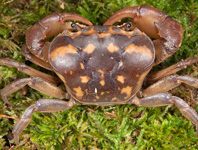Abstract
Five new species of coral inhabiting barnacles of the genus Trevathana (Balanomorpha: Pyrgomatidae), T. dongshaensis sp. nov., T. conica sp. nov., T. doni sp. nov., T. longidonta sp. nov. and T. taiwanus sp. nov., are described. These species are found in West Pacific waters including Japan, Taiwan (mainland and adjacent outlying islands including Dongsha Atoll) and Papua New Guinea. The species exhibit morphological differences in the scutum, the tergum, and cirri II and III, and form distinct clades in a phylogenetic tree based on DNA sequences of two genes, 12S rDNA and cytochrome C oxidase subunit I. Three of the five species, T. dongshaensis sp. nov., T. conica sp. nov. and T. taiwanus sp. nov., have relatively narrow distribution ranges and were recorded from the Dongsha Atoll (T. dongshaensis sp. nov. and T. conica sp. nov.) and the Taiwanese mainland (T. taiwanus sp. nov.). Trevathana longidonta sp. nov. and T. doni sp. nov. have wider distributions. Trevathana longidonta sp. nov. was collected from Japan, Taiwan and Dongsha Atoll and T. doni sp. nov. was collected from Taiwan, Dongsha Atoll and Papua New Guinea. In the waters of Japan, Taiwan and Dongsha Atoll, all the recorded Trevathana species inhabit corals of the family Merulinidae. However, in Papua New Guinea, T. doni sp. nov. is also recorded in the coral Oxypora, belonging to the family Lobophylliidae, and individuals living on Lobophyllidae and Merulinidae did not exhibit great variation in the divergence of the COI and 12S genes.
References
Achituv, Y. & Hosie, A. (2013) Trevathana noae, a new species of coral inhabiting barnacle (Cirripedia: Thoracica: Pyrgomatidae). Zootaxa, 3731 (1), 106–112.
https://doi.org/10.11646/zootaxa.3731.1.4Achituv, Y. & Langzam, Y. (2009) Two new species of Trevathana (Crustacea, Cirripedia, Balanomorpha, Pyrgomatidae) from the Western Indian Ocean and French Polynesia. Zootaxa, 2116, 46–52.
Anderson, D.T. (1992) Structure, function and phylogeny of coral-inhabiting barnacles (Cirripedia, Balanoidea). Zoological Journal of the Linnean Society, 106, 277–339.
https://doi.org/10.1111/j.1096-3642.1992.tb01249.xAnderson, D.T. (1993) Addendum/Corrigendum. Zoological Journal of the Linnean Society, 105, 337.
https://doi.org/10.1111/j.1096-3642.1993.tb00304.xBrickner, I., Loya, Y. & Achituv, Y. (2010) Diverse life strategies in two coral-inhabiting barnacles (Pyrgomatidae) occupying the same host (Cyphastrea chalcidicum), in the northern Gulf of Eilat. Journal of Experimental Marine Biology and Ecology, 392, 220–227.
https://doi.org/10.1016/j.jembe.2010.04.022Brickner, I., Simon-Blecher, N. & Achituv, Y. (2009) Darwin's Pyrgoma (Cirripedia) revisited: Revision of the Savignium Group, molecular analysis and description of new species. Journal of Crustacean Biology, 30, 266–291.
https://doi.org/10.1651/09-3152.1Chan, B., Garm, A. & Høeg, J.T. (2008) Setal morphology and cirral setation of thoracican barnacle cirri: adaptations and implications for thoracican evolution. Journal of Zoology, 275, 294–306.
https://doi.org/10.1111/j.1469-7998.2008.00441.xChan, B.K.K., Chen, Y.Y. & Lin, H.C. (2013) Biodiversity and host specificity of coral barnacles of Galkinia (Cirripedia: Pyrgomatidae) in Taiwan, with descriptions of six new species. Journal of Crustacean Biology, 33, 392–431.
https://doi.org/10.1163/1937240X-00002134Chen, Y.-Y., Lin, H.-C. & Chan, B.K.K. (2012) Description of a new species of coral-inhabiting barnacle, Darwiniella angularis sp. n. (Cirripedia, Pyrgomatidae) from Taiwan. ZooKeys, 214, 43–74.
https://doi.org/10.3897/zookeys.214.3291Darwin, C. (1854) A monograph on the sub-class Cirripedia, with figures of all the species the Balanidae, the Veruucidae, etc. etc. Ray Society, London, 684 pp.
Gray, J.E. (1825) A synopsis of the genera of Cirripedes arranged in natural families, with a description of some new species. Annals of Philosophy, New Series, 10, 97–107.
Hiro, F. (1931) Notes on some new Cirripedia from Japan. Memoirs of the College Science, Kyoto Imperial University, Series B, 7, 143–158.
Kearse, M., Moir, R., Wilson, A., Stones-Havas, S., Cheung, M., Sturrock, S., Buxton, S., Cooper, A., Markowitz, S., Duran, C., Thierer, T., Ashton, B., Mentjies, P. & Drummond, A. (2012) Geneious Basic: an integrated and extendable desktop software platform for the organization and analysis of sequence data. Bioinformatics, 28, 1647–1649.
Kumar, S., Stecher, G. & Tamura, K. (2016) MEGA7: Molecular Evolutionary Genetics Analysis version 7.0 for bigger datasets. Molecular biology and evolution, msw054.
https://doi.org/10.1093/bioinformatics/bts199Leach, W.E. (1817) The zoological miscellany: being descriptions of new, or interesting animals. Vol. 3. B. McMillan for E. Nodder & Son, London, 232 pp.
Malay, M.C.D. & Michonneau, F. (2014) Phylogenetics and morphological evolution of coral-dwelling barnacles (Balanomorpha: Pyrgomatidae). Biological Journal of the Linnean Society, 113, 162–179.
https://doi.org/10.1111/bij.12315Newman, W.A. & Ross, A. (1976) Revision of the balanomorph barnacles: including a catalog of the species. Memoirs of the San Diego Society of Natural History, 9, 1–108.
Pilsbry, H.A. (1916) The sessile barnacles (Cirripedia) contained in the collection of the U.S. National Museum; including a monograph of the American species. Bulletin of the United States National Museum, 93, 1–366.
https://doi.org/10.5479/si.03629236.93.1Ross, A. & Newman, W.A. (1973) Revision of the coral inhabiting barnacles (Cirripedia: Balanidae). Transactions of the San Diego Society of Natural History, 17, 137–174.
Sowerby, J.D. (1823) The genera of fossil and recent shells, for the use of students in conchology and geology. GB Sowerby, London, 544 pp.
Stamatakis, A. (2006) RAxML-VI-HPC: maximum likelihood-based phylogenetic analyses with thousands of taxa and mixed models. Bioinformatics, 22, 2688–2690.
https://doi.org/10.1093/bioinformatics/btl446Stamatakis, A., Hoover, P. & Rougemont, J. (2008) A rapid bootstrap algorithm for the RAxML web servers. Systematic Biology, 57, 758–771.
https://doi.org/10.1080/10635150802429642Su, J. (2004) Overview of the South China Sea circulation and its influence on the coastal physical oceanography outside the Pearl River Estuary. Continental Shelf Research, 24, 1745–1760.
https://doi.org/10.1016/j.csr.2004.06.005Thompson, J.D., Gibson, T.J., Plewniak, F., Jeanmougin, F. & Higgins, D.G. (1997) The CLUSTAL_X windows interface: Flexible strategies for multiple sequence alignment aided by quality analysis tools. Nucleic Acids Research, 25, 4876–4882.
https://doi.org/10.1093/nar/25.24.4876Tsang, L.M., Chu, K.H., Nozawa, Y. & Chan, B.K.K. (2014) Morphological and host specificity evolution in coral symbiont barnacles (Balanomorpha: Pyrgomatidae) inferred from a multi-locus phylogeny. Molecular Phylogenetics and Evolution, 77, 11–22.
https://doi.org/10.1016/j.ympev.2014.03.002

